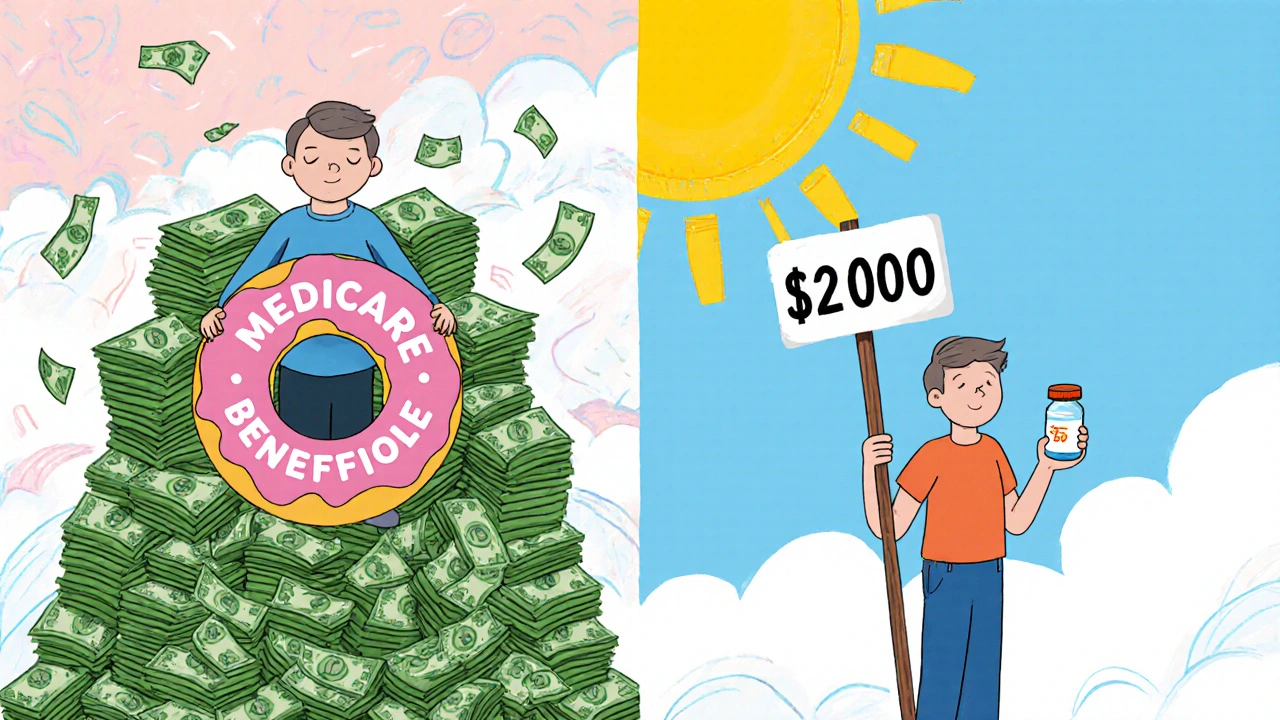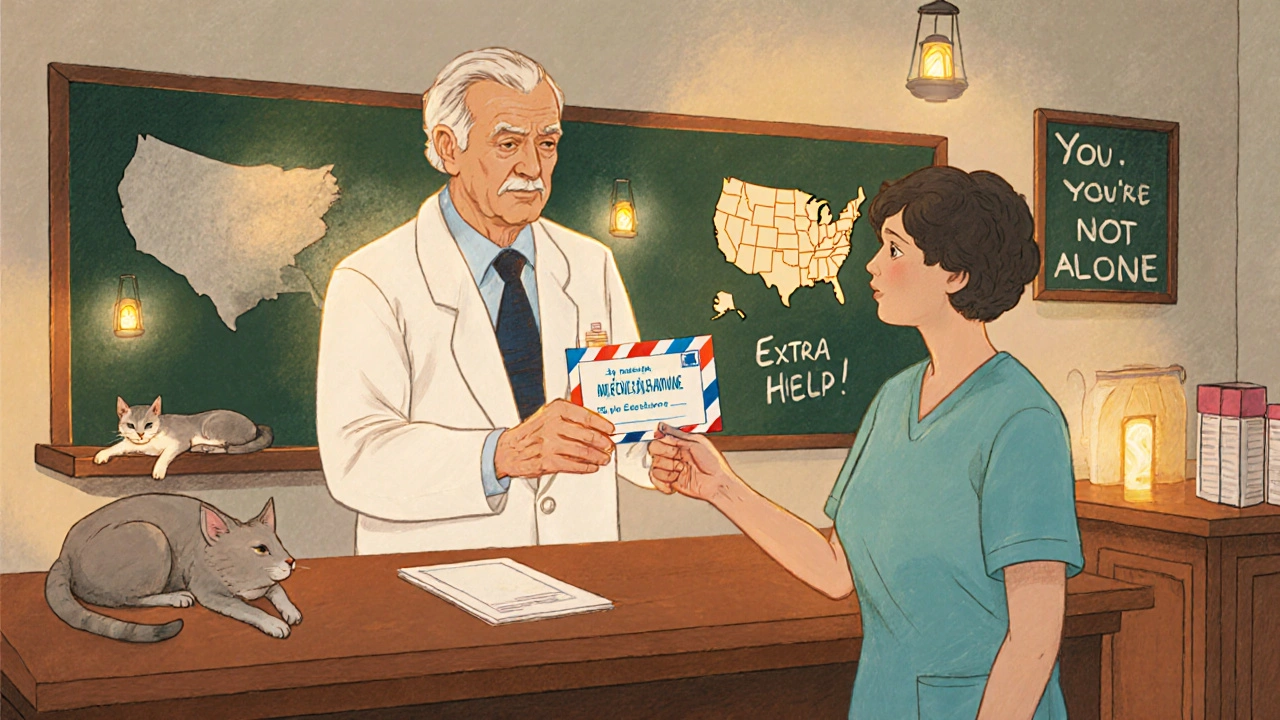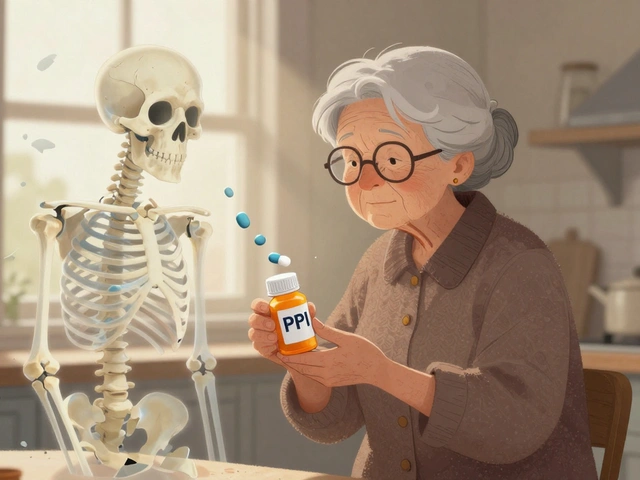
By the end of 2024, millions of Medicare beneficiaries will face a confusing and costly phase called the donut hole-a coverage gap where out-of-pocket drug costs spike after you and your plan have spent a certain amount on prescriptions. But here’s the good news: starting January 1, 2025, this gap will disappear entirely. For now, though, if you’re in the donut hole or close to it, you need to know how to protect your wallet.
What the Donut Hole Actually Means in 2024
The donut hole isn’t a loophole-it’s a phase in Medicare Part D coverage. Once you and your plan have spent $5,030 on covered drugs in 2024, you enter the coverage gap. You’re not out of coverage, but you pay more. For brand-name drugs, you pay 25% of the cost. For generics, you pay 25% too. Sounds fair, right? But here’s the catch: the 70% discount drug manufacturers give on brand-name meds doesn’t count toward your out-of-pocket spending. Only your 25% does. That means if you take expensive biologics like Humira or Repatha, you’re still paying hundreds or even over a thousand dollars a month out of pocket.Meanwhile, if you’re on mostly generics, you’ll hit the catastrophic coverage threshold much later-around $6,000 in out-of-pocket spending. That’s because manufacturer discounts don’t apply to generics. So your path out of the donut hole is longer and more expensive.
Why the Donut Hole Is Vanishing in 2025
The Inflation Reduction Act of 2022 didn’t just tweak the system-it rewrote it. Starting January 1, 2025, there will be no more donut hole. Instead, there’s a hard cap: $2,000 per year in out-of-pocket drug costs. After you hit that, your Part D plan covers 100% of your prescription costs for the rest of the year. That’s a massive change. In 2024, many beneficiaries spent over $7,000 before hitting catastrophic coverage. In 2025, you’ll never pay more than $2,000.Manufacturers will still offer discounts, but they’ll be structured differently. Instead of a 70% discount during the gap, they’ll pay 10% during initial coverage and 20% during catastrophic coverage. The government is stepping in to fill the rest. This simplifies everything. No more tracking discounts. No more confusion about what counts toward your limit.
Who Gets Hit Hardest Right Now?
If you’re taking one or two high-cost brand-name drugs-like those for rheumatoid arthritis, multiple sclerosis, or cancer-you’re in the danger zone. In 2022, about 19% of Medicare Part D enrollees reached the coverage gap. For those people, average annual savings from the 2025 cap will be nearly $1,000. That’s not a small number. It’s rent. It’s groceries. It’s skipping a dose to make the next month last.Reddit threads and Medicare forums are full of stories. One user described paying $1,200 a month for Humira during the gap. Another split pills to stretch their supply. A third used Amgen’s patient assistance program to drop their Repatha cost from $560 to $5 a month. These aren’t rare cases. AARP’s 2023 survey found that 74% of people who entered the donut hole didn’t know about cost-saving tools until they were already in it.

Five Proven Ways to Lower Costs Before 2025
- Check your plan’s formulary tier. Not all drugs are created equal. Tier 3 or 4 drugs cost more. If your medication is on a higher tier, ask your doctor if there’s a similar drug on Tier 2. Even a small switch can save hundreds.
- Use manufacturer patient assistance programs. Most big drugmakers have them. Companies like AbbVie, Pfizer, and Amgen offer copay cards, free drug programs, or discounts. Apply early. You don’t need to be poor to qualify. Many programs accept anyone with Medicare Part D. One 2023 study showed these programs cut brand-name drug costs by 63% to 92%.
- Switch to generics when possible. If your doctor says it’s safe, switching from a brand-name statin to a generic atorvastatin can save you $1,200 to $2,500 a year. Same goes for metformin, lisinopril, or levothyroxine. Generic versions are just as effective.
- Get 90-day supplies. Mail-order pharmacies often charge less per pill. A 90-day supply might cost the same as two 30-day fills. That means fewer copays and fewer trips to the pharmacy. Medicare.gov confirms this can reduce your monthly costs by 15% to 25%.
- Apply for Extra Help (Low-Income Subsidy). If your income is below $22,590 (single) or $30,660 (couple) in 2024, you may qualify. Extra Help covers your deductible, lowers your copays, and eliminates the donut hole entirely. Over 12 million people got it in 2023. If you’re unsure, call 1-800-MEDICARE or visit Social Security’s website. It takes 10 minutes to apply.
Use the Medicare Plan Finder Before Next Year
Don’t wait until open enrollment to check your plan. Use the Medicare Plan Finder right now. Type in your exact medications, dosages, and pharmacy. Compare plans side by side. You might be shocked. One person in Brisbane switched from a $50/month plan with high copays to a $30/month plan with better drug coverage-and saved $1,200 a year. The National Council on Aging says people who optimize their plan save an average of $1,047 annually.Look for plans that cover your drugs in lower tiers. Check if they have preferred pharmacies. See if they offer mail-order. Even small differences add up fast when you’re in the donut hole.

What to Do When You’re Already in the Gap
If you’re already paying 25% of high drug costs, don’t panic. Start with these steps:- Call your pharmacy. Ask if your drug has a manufacturer coupon or discount card. Many are hidden behind a website search.
- Ask your doctor for a 90-day prescription. Fewer refills = fewer copays.
- Check if your state has a Medicare Savings Program. Thirty-seven states offer extra help with premiums and out-of-pocket costs. You don’t need to be on Medicaid to qualify.
- Don’t skip doses. Studies show 32% of people in the gap skip pills to save money. That leads to ER visits, hospitalizations, and higher long-term costs.
- Set up a budget. Track every drug expense. Know how close you are to $8,000 in total spending. That’s when catastrophic coverage kicks in.
Prepare for 2025-Even If You’re Not in the Gap Yet
The changes in 2025 aren’t just about the donut hole disappearing. They’re about simplifying your entire drug coverage. Here’s what to do now:- Read your Annual Notice of Change (ANC). Plans mailed these in September 2024. They tell you exactly how your premiums, copays, and coverage will change next year.
- Update your Medicare Plan Finder with your current meds. See which plans will be cheapest under the new $2,000 cap.
- Ask your pharmacist if your drugs will still be covered. Some plans will drop certain brand-name drugs or change tiers.
- Don’t assume your current plan is still the best. Premiums are projected to drop slightly in 2025, but coverage can shift.
The Bigger Picture: Why This Matters
The donut hole wasn’t just a financial burden-it was a health risk. When people couldn’t afford their meds, their conditions worsened. Hospital admissions for uncontrolled diabetes, heart failure, and high blood pressure went up. The Medicare Payment Advisory Commission estimates the $2,000 cap will reduce prescription abandonment by 18% to 22%. That could save the system $1.2 billion a year in avoided hospital care.This isn’t just policy. It’s personal. It’s about a senior choosing between insulin and their electric bill. It’s about a veteran with arthritis skipping doses because they can’t afford the copay. The 2025 cap doesn’t fix everything-premiums, pharmacy networks, and formulary changes still matter. But it ends the worst part: the fear that your medication will suddenly become unaffordable.
Is the donut hole gone in 2025?
Yes. Starting January 1, 2025, the Medicare Part D coverage gap (donut hole) will be eliminated. Instead, there’s a $2,000 annual out-of-pocket cap on prescription drug costs. Once you hit that limit, your plan covers 100% of your covered drugs for the rest of the year.
How do I know if I’m in the donut hole in 2024?
You’re in the donut hole when your total drug costs (what you paid plus what your plan paid) reach $5,030 in 2024. You’ll get a notice from your plan, but you can also track it yourself using the Medicare Plan Finder tool or by keeping a log of each prescription fill. Your out-of-pocket spending includes deductibles, copays, and coinsurance-not premiums.
Do manufacturer discounts count toward the $2,000 cap in 2025?
No. The $2,000 cap is based only on what you pay out of pocket. Manufacturer discounts, including the new 10% and 20% payments, don’t count toward your cap. The government covers the rest. This makes it simpler: you pay up to $2,000, then everything else is free.
Can I still use manufacturer coupons after 2025?
Yes, but they’ll work differently. Instead of reducing your cost during the donut hole, manufacturer discounts will now be applied during initial coverage and catastrophic coverage. You’ll still pay less upfront, but the $2,000 cap is your real safety net. Don’t rely on coupons alone-they’re helpful, but not guaranteed.
What if I can’t afford my meds even with the $2,000 cap?
The $2,000 cap is a big step, but it’s not the end. If you’re still struggling, apply for Extra Help (Low-Income Subsidy). It can cover your premiums, reduce your copays, and eliminate your deductible. You can also check if your state offers a Medicare Savings Program. These programs help with premiums and out-of-pocket costs-even if you’re not eligible for Medicaid.
Should I switch plans before 2025?
If you’re taking expensive drugs, yes. Even though the donut hole is ending, plan networks, formularies, and premiums are changing. Use the Medicare Plan Finder now to compare plans under the new $2,000 cap structure. The plan that was cheapest in 2024 might not be the best in 2025. Don’t wait until October-start now.







Austin Simko
November 29, 2025 AT 00:54This is all government propaganda. The donut hole never existed-it was just a way to make you think you’re getting help while they secretly raise premiums. 2025? More like 2025 lies.
Nicola Mari
November 30, 2025 AT 07:04I find it appalling that people still don’t realize they’re being manipulated by pharmaceutical corporations. If you’re spending over $2,000 on medication, you’re either mismanaged your health or you’ve been lazy about finding alternatives. This isn’t a crisis-it’s a consequence.
Sam txf
November 30, 2025 AT 14:37Let me tell you something real-these drug companies are laughing all the way to the bank. They’ve been padding prices for years, and now they’re slapping on a 10% discount like it’s a gift? Nah. The real win is the government stepping in to cover their mess. Don’t fall for the fairy tale. This isn’t reform-it’s damage control with a pretty ribbon.
Michael Segbawu
November 30, 2025 AT 17:09Im in the gap right now paying 1200 a month for my biologic and you think this is going to fix anything. The system is rigged. The rich get discounts the poor get screwed. 2025 is too late for me. I need help now not some future promise from politicians who dont even know what insulin is
Aarti Ray
December 2, 2025 AT 10:51My aunt in Delhi uses the same medicine as me but pays less than 50 rupees because of India’s pricing laws. Why can’t America do this. I know its complicated but people are dying over cost. I hope 2025 helps. Please let it help
Alexander Rolsen
December 3, 2025 AT 03:32...and yet... you still haven’t mentioned the elephant in the room: the fact that Medicare Part D is the only federal program that is legally prohibited from negotiating drug prices. That’s not an oversight-it’s a policy choice. And now, after decades of lobbying, they’re finally capping out-of-pocket costs? Only after people died. Only after the headlines got bad. Only after the public outcry became impossible to ignore. This isn’t compassion. It’s crisis management. And it’s too little. Too late.
Leah Doyle
December 4, 2025 AT 17:08I just found out my mom hit the donut hole last month and had to skip her heart meds for 10 days... 😔 I didn’t even know this was a thing. Thank you for listing the patient programs-my sister applied for Extra Help today and we’re already down $400/month. You’re right-we need to talk about this more. ❤️
Alexis Mendoza
December 5, 2025 AT 18:17It’s strange how we treat medicine like a luxury. We don’t make people choose between food and electricity to survive, but we do it with insulin. Maybe the real problem isn’t the donut hole. Maybe it’s that we’ve normalized suffering as part of the system. The $2,000 cap is a start. But we need to ask: why did it take this long to get here?
Michelle N Allen
December 7, 2025 AT 14:13So I read all this and honestly I’m just tired. I mean I get it the donut hole sucks and 2025 is supposed to be better but like what do I even do now. I’m on a fixed income and my pharmacy doesn’t even tell me about coupons. I just show up and pay. I don’t have time to research every drug or call 1-800-MEDICARE every week. It’s exhausting. I just want to live without thinking about pills every day.
Madison Malone
December 8, 2025 AT 20:00You’re not alone. I’ve been there too. The key is to start small-just one step today. Call your pharmacist and ask if they have a discount card. Or check one program-just one. You don’t have to fix everything at once. And if you need help filling out a form, I’ll walk you through it. You deserve to breathe easy. This isn’t your fault. You’re doing better than you think.